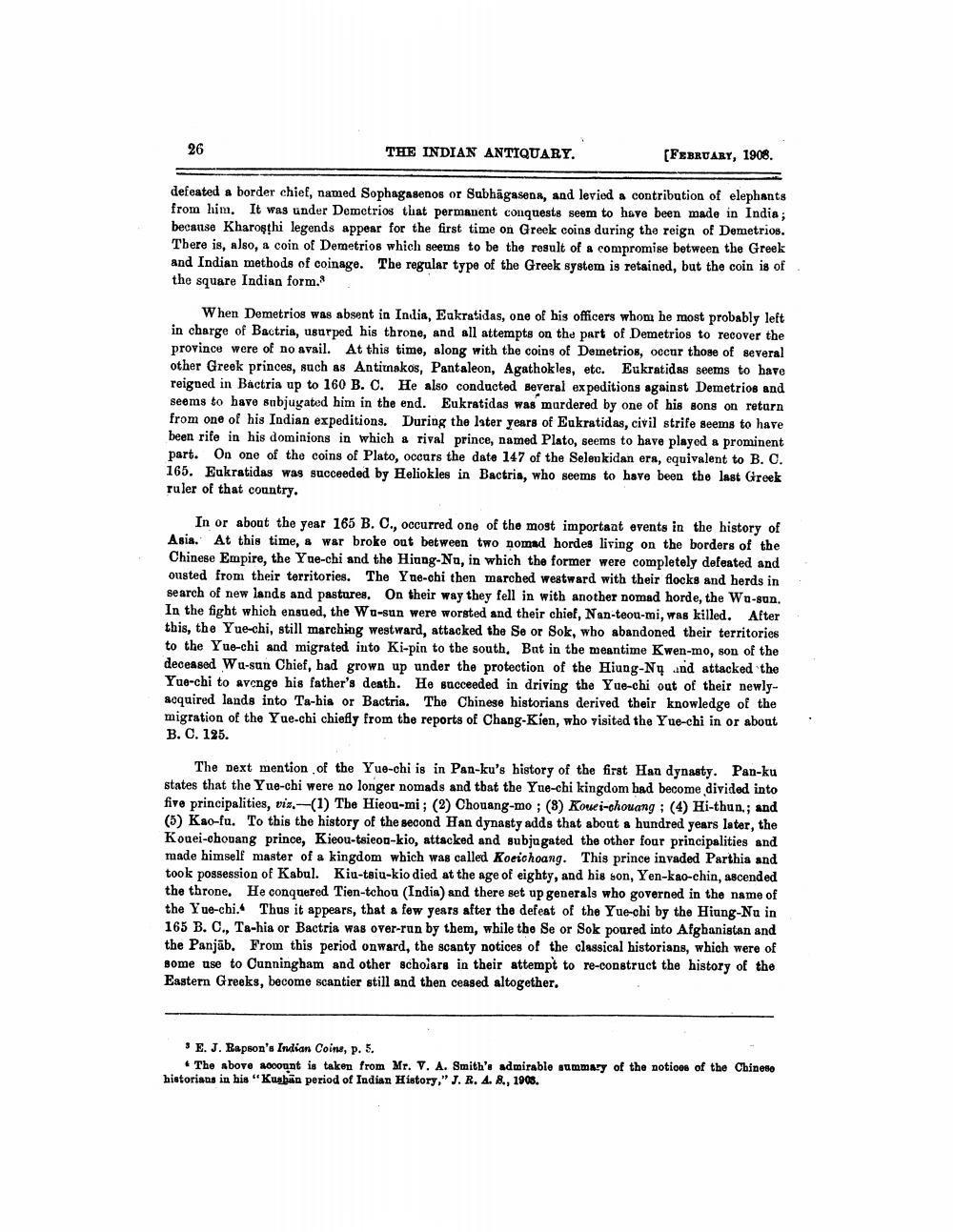________________
26
THE INDIAN ANTIQUARY.
(FEBRUARY, 1908.
defeated a border chief, named Sophagasenos or Subhāgasens, and levied a contribution of elephants from him. It was under Demetrios that permanent conquests seem to have been made in India; because Kharoşthi legends appear for the first time on Greek coins during the reign of Demetrios. There is, also, a coin of Demetrios which seems to be the result of a compromise between the Greek and Indian methods of coinage. The regular type of the Greek system is retained, but the coin is of the square Indian form.
When Demetrios was absent in India, Eukratidas, one of his officers whom he most probably left in charge of Bactria, usurped his throne, and all attempts on the part of Demetrios to recover the province were of no avail. At this time, along with the coins of Demetrios, occur those of several other Greek princes, such as Antimnakos, Pantaleon, Agathokles, etc. Eukratidas seems to bave reigned in Bactria up to 160 B. C. He also conducted Beveral expeditions against Demetrios and seems to have subjugated him in the end. Eukratidas was murdered by one of his sons on return from one of his Indian expeditions. During the later years of Eukratidas, civil strife seems to have been rife in his dominions in which a rival prince, named Plato, seems to have played a prominent part. On one of the coins of Plato, occurs the date 147 of the Seleukidan era, equivalent to B. O. 165. Eukratidas was succeeded by Heliokles in Bactria, who seems to have been the last Greek ruler of that country.
In or about the year 165 B. C., occurred one of the most importaat events in the history of Asia. At this time, & war broke out between two nomad hordes living on the borders of the Chinese Empire, the Yne-chi and the Hiung-Na, in which the former were completely defeated and ousted from their territories. The Yue-chi then marched westward with their flocks and herds in search of new lands and pastures. On their way they fell in with another nomad horde, the Wu-sun. In the fight which ensued, the Wu-sun were worsted and their chief, Nan-teou-mi, was killed. After this, the Yue-chi, still marching westward, attacked the Se or Sok, who abandoned their territories to the Yue-chi and migrated into Ki-pin to the south. Bat in the meantime Kwen-mo, son of the deceased Wu-san Chief, had grown up under the protection of the Hiung-Ny and attacked the Yue-chi to avenge his father's death. He succeeded in driving the Yue-chi out of their newlyacquired lands into Ta-his or Bactria. The Chinese historians derived their knowledge of the migration of the Yue-chi chiefly from the reports of Chang-Kien, who visited the Yue-chi in or about B. C. 125.
The next mention of the Yue-chi is in Pan-ku's history of the first Han dynasty. Pan-ku states that the Yue-chi were no longer nomads and that the Yue-chi kingdom had become divided into five principalities, viz.-(1) The Hieou-mi; (2) Chouang-mo; (8) Kouei-chouang : (4) Hi-thun; and (5) Kao-fu. To this the history of the second Han dynasty adds that about a hundred years later, the Kouei-chouang prince, Kieou-tsieoo-kio, attacked and subjugated the other four principalities and made himself master of a kingdom which was called Koeichoang. This prince invaded Parthia and took possession of Kabul. Kiu-tsiu-kio died at the age of eighty, and his son, Yen-kao-chin, ascended the throne. He conquered Tien-tchou (India) and there set up generals who governed in the name of the Yue-chi. Thus it appears, that a few years after the defeat of the Yue-chi by the Hiung-Nu in 165 B. C., Ta-hia or Bactria was over-run by them, while the Se or Sok poured into Afghanistan and the Panjab. From this period onward, the scanty notices of the classical historians, which were of some use to Cunningham and other scholars in their attempt to re-construct the history of the Eastern Greeks, become scantier still and then ceased altogether.
E. J. Rapson's Indian Coins, p. 5.
• The above account is taken from Mr. V. A. Smith's admirable summary of the notices of the Chinese historiaas in his "Kusban period of Indian History," J. R. 4. &., 1908.




